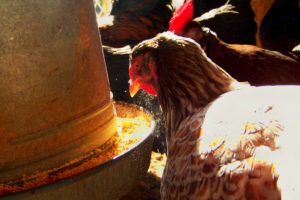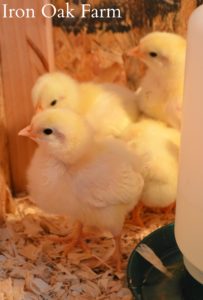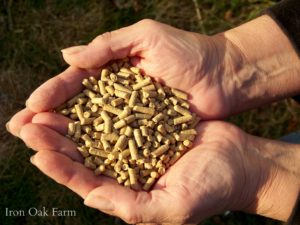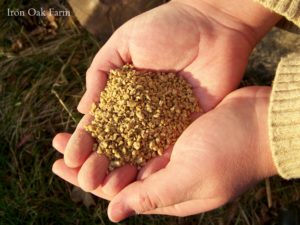 Rolling through the chicken feed aisle at our local farm-supply store can feel a little overwhelming. The “chicken diet” options have come a long way since I first brought home 6 broiler chickens when I was 14 and a bag of cracked corn.
Rolling through the chicken feed aisle at our local farm-supply store can feel a little overwhelming. The “chicken diet” options have come a long way since I first brought home 6 broiler chickens when I was 14 and a bag of cracked corn.
Our local feed store not only carries several brands of chicken feed but varieties as well. Some are starter, grower, crumbles pellets, some add omegas some are for feather growth, laying birds only…it can be difficult to make sure you’re buying the right food for your chickens.
Basically there are a few things you need to know about feeding chickens and buying commercial feed. You have to consider age, the size/type of food and then there are a few specialty options, treats, and suppliants.
Feed by Age
As a rule, the more protein a feed has, the more expensive. Chickens need the most protein when they’re young. Thankfully, they only have to be on a more pricey feed for the first couple of months of their lives.
Often, types of feed are separated by protein content which correlates to the age of the chicken.
Starter
 Hatch to 8 weeks
Hatch to 8 weeks- 20% protein
Starter feed should be fed to chicks from the beginning of life. It offers a balanced, complete diet to newborn chicks.
Grower
- 8-20 weeks
- 16% protein
Grower is a transition feed used for adolescent chicks. It cuts back on the protein content which is better for liver health. It is usually less expensive than starter feeds.
Starter/Grower
- Hatch to 20 weeks
- 16-18% protein
 To further confuse things, some feed companies sell a Starter/Grower feed that will serve your chicks from hatch to laying age without a transitional feed. This simplifies the process, especially if you get chicks from a breeder and aren’t exactly sure of their age.
To further confuse things, some feed companies sell a Starter/Grower feed that will serve your chicks from hatch to laying age without a transitional feed. This simplifies the process, especially if you get chicks from a breeder and aren’t exactly sure of their age.
Layer
- 20 weeks and on through adulthood
- 16-18% protein plus added calcium
Layer feed is designed to supply laying hens with everything they need to keep a healthy weight and to supply enough calcium for nicely formed eggshells.
Feed by Size/Type
In general, chicken feed is available in three types:
- Mash
- Pellets
- Crumble
Mash:
Most chicken feed starts out as mash. It’s a blend of milled/semi milled grains, soy, wheat, corn, and other additives. The texture of mash os sort of a powdery blend with bits of unprocessed grains.
Often mash is the least expensive feed available because it goes through the least amount of processes. Some people add water to make a sort of oatmeal consistency.
Mash (in my opinion) is the messiest of the chicken feed options. If you don’t add water, the powdery consistency is easily wasted. The chickens also tend to pick out the larger chunks of grains and scatter the more fine bits. If you add water, this helps; however, if the feed isn’t eaten in all one sitting, it can get moldy, attract flies, and can be hard to clean out of feeders.
Pellets:
 As chicken feed processing goes, pellets would be the next step. Pellets are made by compressing mash into a pellet shape. It creates a uniform feed shape (think dog kibble). Pellets are (in my opinion) the least wasteful type of feed. The larger morsels make for a cleaner feeder and the chickens get full faster without throwing feed everywhere. Pellets should only be offered to adult chickens due to the size.
As chicken feed processing goes, pellets would be the next step. Pellets are made by compressing mash into a pellet shape. It creates a uniform feed shape (think dog kibble). Pellets are (in my opinion) the least wasteful type of feed. The larger morsels make for a cleaner feeder and the chickens get full faster without throwing feed everywhere. Pellets should only be offered to adult chickens due to the size.
Crumble:
 Crumble is made from coarsely grinding pellets. It offers a uniform feed, but in smaller morsels. Most commercial starter feed is in crumble form so small birds can easily pick up the bites. Bantams also do well with crumble size feed.
Crumble is made from coarsely grinding pellets. It offers a uniform feed, but in smaller morsels. Most commercial starter feed is in crumble form so small birds can easily pick up the bites. Bantams also do well with crumble size feed.
Medicated vs Unmedicated
Medicated feed contains ingredients used to combat common diseases/parasites that affect young chicks. The most common is Cocciodosis, a protozoan that infects the digestive system.
If your chicks are vaccinated, you should check with your veterinarian before feeding medicated feed. Some of the ingredients in medicated feed will interact negatively with vaccinations.
Medicated feed should also not be fed to baby waterfowl.
Supplements
Chickens also do well with the addition of a few supplements. These should be offered free choice in separate containers from feed.
Oyster Shell:
Oyster shell offers calcium to laying hens. It should be offered especially if you notice shell-less eggs. (An egg with a soft rubbery shell)
Grit:
Grit or small stones offer non-free range chickens a way to digest their food. In the wild, chickens will consume small stones that settle in the gizzard and grind together to break apart feed.
Chick grit is also available in smaller stone sizes. It can be sprinkled over chick feed.
Scratch:
Scratch is a treat and should only be fed in moderation. (Less than 5% of the total diet.) Scratch can be used to fight boredom, chickens enjoy scratching and pecking at the whole grain morsels. But scratch is an incomplete protein and when fed in high amounts can lead to feather picking and other destructive behaviors.
Fermented
Fermenting chicken feed makes the feed easier to digest and makes nutrients more readily available to the chicken. It also reduces droppings and feed cost because the chickens don’t need as much feed to keep them full and healthy.













1 Comment
Looking for a list of extras you do not feed your ducks and chickens.
The Shade plants? Potatoes?
Vicki